1998 GMC SIERRA engine
[x] Cancel search: enginePage 238 of 452

If You Do Decide To Pull A Trailer
If you do, here are some important points:
0
0
0
0
There are many different laws, including speed limit
restrictions, having to
do with trailering. Make sure
your rig will be legal, not only where you live but
also where you’ll be driving.
A good source for this
information
can be state or provincial police.
Consider using
a sway control if your trailer will
weigh less than
the capacity stamped on your step
bumper. You should always use a sway control
if
your trailer will weigh more than the capacity
stamped
on your step bumper. You can ask a hitch
dealer about sway controls.
Don’t tow a trailer at all during the first
500 miles
(800 km) your new vehicle is driven. Your engine,
axle or other parts could be damaged.
Then, during the first
500 miles (800 km) that you
tow
a trailer, don’t drive over 50 mph (80 kdh) and
don’t make starts at
full throttle. This helps your
engine and other parts
of your vehicle wear in at the
heavier loads.
0 If you have an automatic transmission, you can tow
in OVERDRIVE
(a). You may want to shift the
transmission to
THIRD (3) or, if necessary, a lower
gear selection if the transmission shifts too often
(e.g., under heavy loads and/or
hilly conditions). If
you have
a manual transmission and you are towing
a trailer, it’s better not to use
FIFTH (5) gear. Just
drive
in FOURTH (4) gear (or, as you need to, a
lower gear).
Three important considerations have
to do with weight:
0 the weight of the trailer,
0 the weight of the trailer tongue
0 and the weight on your vehicle’s tires.
Weigl- - 3e Trailer
How heavy can a trailer safely be?
It depends
on how you plan to use your rig. For
example, speed, altitude, road grades, outside
temperature and how much your vehicle is used to
pull a
trailer are all important. And,
it can also depend on any
special equipment that you have
on your vehicle.
4-50
ProCarManuals.com
Page 239 of 452
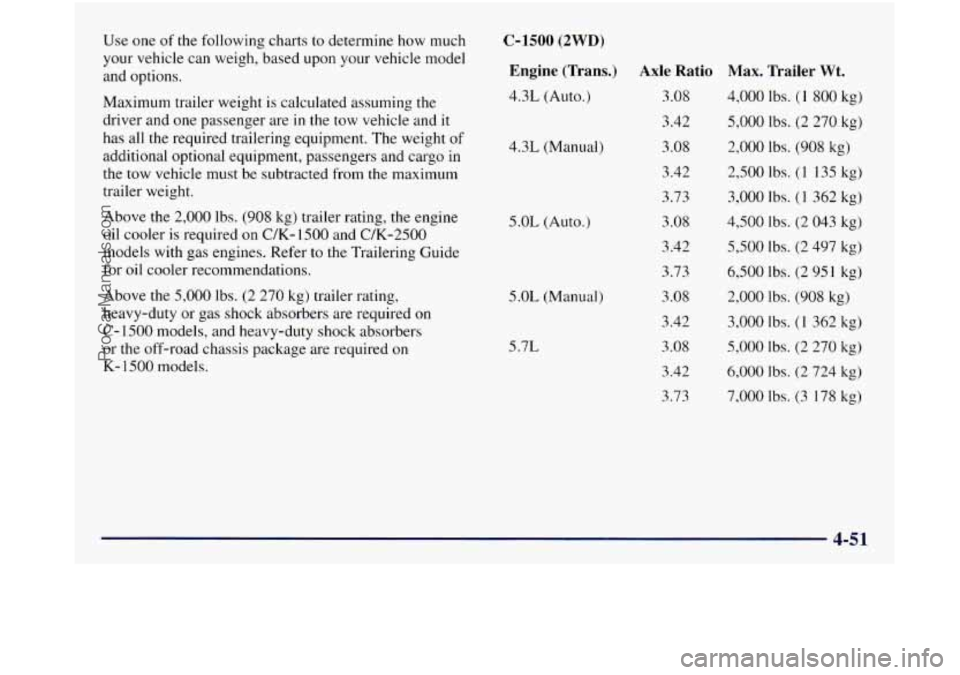
Use one of the following charts to determine how much
your vehicle can weigh, based upon your vehicle model
and options.
Maximum trailer weight is calculated assuming the
driver and one passenger are in the tow vehicle and
it
has all the required trailering equipment. The weight of
additional optional equipment, passengers and cargo in
the tow vehicle must be subtracted from the maximum
trailer weight.
Above the
2,000 lbs. (908 kg) trailer rating, the engine
oil cooler
is required on C/K- 1500 and C/K-2500
models with gas engines. Refer
to the Trailering Guide
for oil cooler recommendations.
Above the
5,000 lbs. (2 270 kg) trailer rating,
heavy-duty or gas shock absorbers are required
on
C- 1500 models, and heavy-duty shock absorbers
or the off-road chassis package are required on
K- 1500 models.
C-1500 (2WD)
Engine (Trans.)
4.3L (Auto.)
4.3L (Manual)
5.0L (Auto.)
5.0L (Manual)
5.x
Axle Ratio 3.08
3.42
3.08
3.42
3.73
3.08
3.42
3.73
3.08
3.42
3.08
3.42
3.73
Max. Trailer Wt.
4,000 lbs. (1 800 kg)
5,000 lbs. (2 270 kg)
2,000 lbs.
(908 kg)
2,500 lbs.
(1 135 kg)
3,000 lbs.
(1 362 kg)
4,500 lbs.
(2 043 kg)
5,500 Ibs. (2 497 kg)
6,500 Ibs. (2 951 kg)
2,000 lbs.
(908 kg)
3,000 Ibs. (1 362 kg)
5,000 lbs. (2 270 kg)
6,000 lbs. (2 724 kg)
7,000 lbs. (3 178 kg)
4-51
ProCarManuals.com
Page 240 of 452
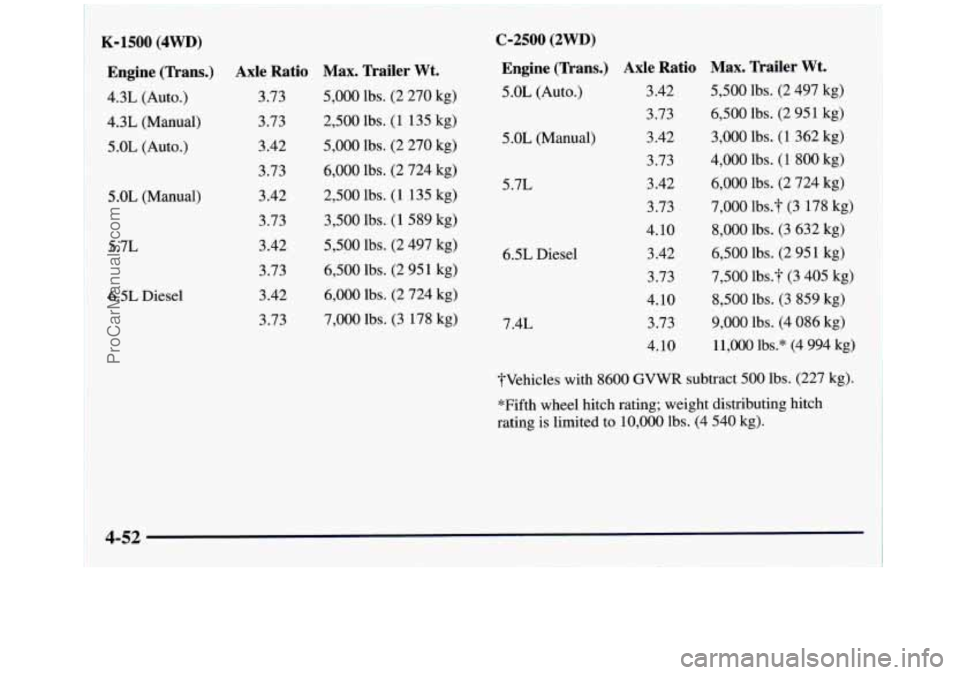
1 K-1500 (4WD)
~ Engine (Trans.) Axle Ratio 4.3L
(Auto.) 3.73
1 4.3L
(Manual)
i 5.0L (Auto.)
5
.OL (Manual)
5.7L 6.5L Diesel 3.73
3.42
3.73
3.42 3.73
3.42
3.73
3.42
3.73
Max. Trailer Wt.
5,000 lbs. (2 270 kg)
2,500 lbs. (1 135 kg)
5,000 lbs. (2 270 kg)
6,000 lbs. (2 724 kg)
2,500 lbs. (1 135 kg)
3,500 lbs. (1 589 kg)
5,500 lbs. (2 497 kg)
6,500 lbs. (2 951 kg)
6,000 lbs. (2 724 kg)
7,000 lbs. (3 178 kg) 5 .OL (Manual)
5.7L
6.5L Diesel
7.4L
C-2500 (2WD) Engine (Trans.) Axle Ratio
5.0L (Auto.) 3.42
3.73
3.42
3.73
3.42
3.73
4.10
3.42 3.73
4.10 3.73
4.10
Max. Trailer Wt.
5,500 lbs. (2 497 kg)
6,500 lbs. (2 951 kg)
3,000 lbs. (1 362 kg)
4,000 lbs. (1 800 kg)
6,000 lbs.
(2 724 kg)
7,000 lbs.3' (3 178 kg)
8,000 lbs. (3 632 kg)
6,500 lbs. (2 951 kg)
7,500 1bs.T (3
405 kg)
8,500 lbs. (3 859 kg)
9,000 lbs. (4 086 kg)
11,OOO lbs.* (4 994 kg)
?Vehicles with
8600 GVWR subtract 500 lbs. (227 kg).
*Fifth wheel hitch rating; weight distributing hitch
rating is limited to 10,000 lbs. (4 540 kg).
ProCarManuals.com
Page 241 of 452
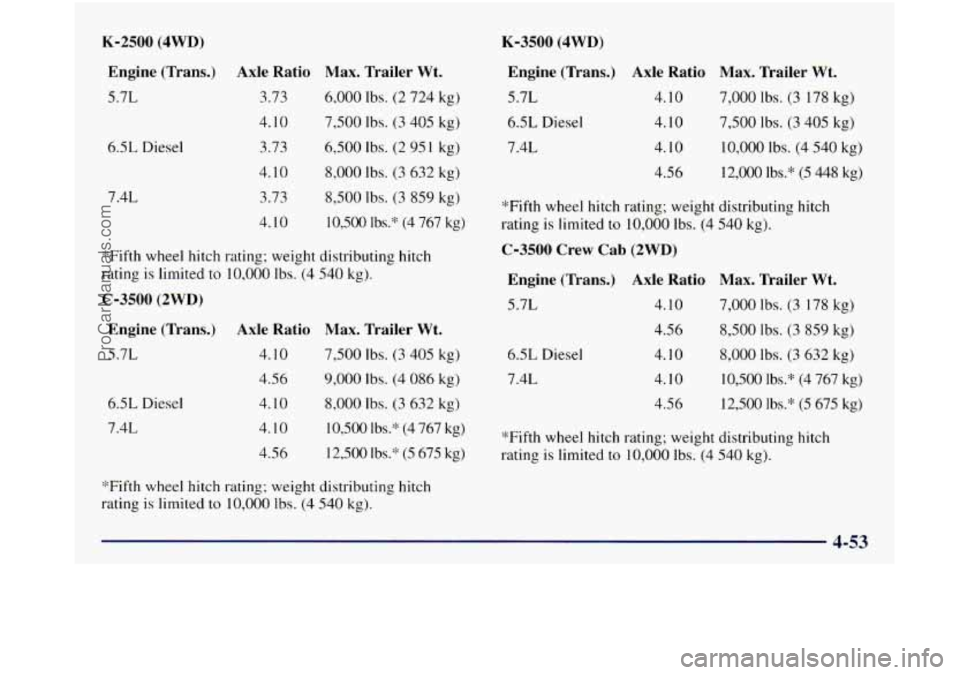
K-2500 (4WD)
Engine (Trans.) Axle Ratio Max. Trailer Wt.
5.7L 3.73 6,000 lbs. (2 724 kg)
3.73 6,500 Ibs.
(2 95 1 kg)
3.73
8,500 lbs. (3 859 kg)
4.10 10,500 lbs.* (4 767 kg)
4.10 7,500
lbs. (3 405 kg)
4.10 8,000 Ibs. (3 632 kg)
6.5L
Diesel
7.4L
*'Fifth wheel hitch rating; weight distributing hitch
rating is limited to 10,000 Ibs. (4 540 kg).
C-3500 (2WD)
6.5L Diesel
7.4L
Engine (Trans.) Axle Ratio Max. Trailer Wt.
5.7L 4.10 7,500 lbs. (3 405 kg)
4.56 9,000 lbs. (4 086 kg)
4.10
8,000 lbs. (3 632 kg)
4.10 10,500 lbs." (4 767 kg)
4.56 12,500 Ibs."
(5 675 kg)
"Fifth wheel hitch rating; weight distributing hitch
rating is limited
to 10,000 lbs. (4 540 kg).
K-3500 (4WD)
Engine (Trans.) Axle Ratio Max. Trailer Wt.
5.7L 4.10 7,000 lbs. (3 178 kg)
7.4L 4.10 10,000 lbs. (4 540 kg)
6.5L
Diesel 4.10 7,500 lbs. (3 405 kg)
4.56 12,000 lbs.* (5
448 kg)
*Fifth wheel hitch rating; weight distributing hitch
rating is limited to 10,000 Ibs. (4 540 kg).
C-3500 Crew Cab (2WD)
6.5L Diesel
7.4L
Engine (Trans.) Axle Ratio Max. Trailer Wt.
5.7L 4.10 7,000 lbs. (3 178 kg)
4.56 8,500 lbs.
(3 859 kg)
4.10 8,000 lbs.
(3 632 kg)
4.10 10,500
lbs." (4 767 kg)
4.56 12,500 lbs."
(5 675 kg)
*Fifth wheel hitch rating; weight distributing hitch
rating is limited to 10,000 Ibs. (4 540
kg).
4-53
ProCarManuals.com
Page 242 of 452
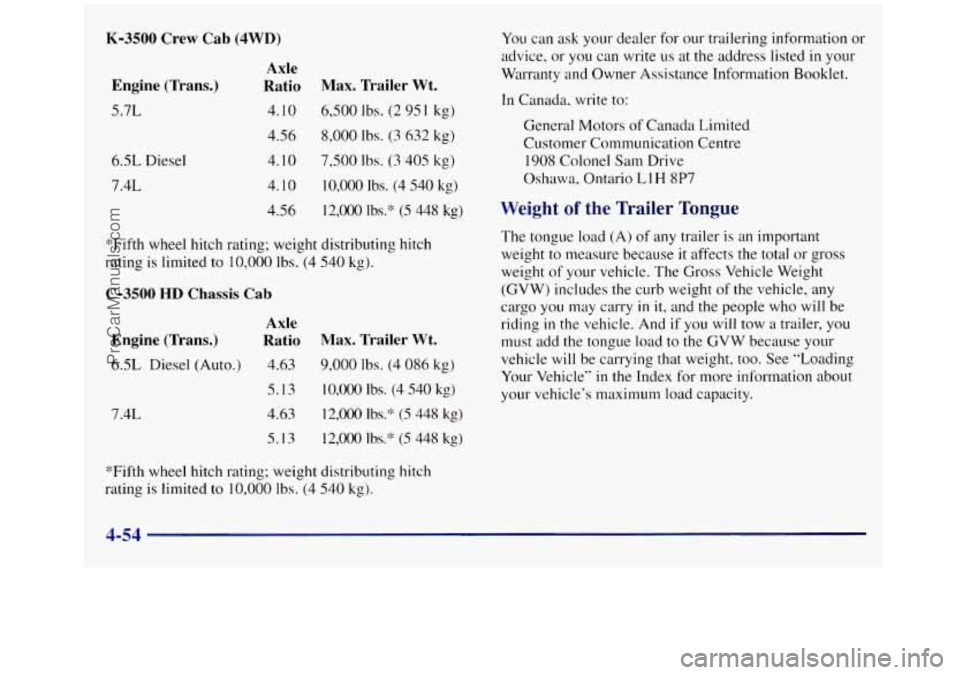
K-3500 Crew Cab (4WD)
Engine (Trans.)
5.7L
6.5L Diesel
7.4L
Axle
Ratio Max. Trailer Wt.
4.10 6,500 Ibs. (2 95 I kg)
4.56 8,000 lbs.
(3 ti32 kg)
4.10 7,500 Ibs.
(3 405 kg)
4.10
10,000 Ibs. (4 540 kg)
4.56 12,000
Ibs.'% (5 448 kg)
*Fifth wheel hitch rating; weight distributing hitch
rating is limited to
10,000 lbs. (4 540 kg).
C-3500 HD Chassis Cab
Engine (Trans.)
6.5L Diesel (Auto.)
7.4L
Axle
Ratio Max. Trailer Wt.
4.63 9,000 lbs. (4 084 kg)
5.1
3 10,OOO Ibs. (4 540 kg)
4.63
12,000 Ibs.'': (5 448 kg)
5.1
3 12,000 Ibs." (5 448 kg) You
can ask your dealer for
our trailering information or
advice, or you can write us at the address listed
in your
Warranty and Owner Assistance Information Booklet.
In Canada, write to:
General Motors of Canada Limited
Customer Communication Centre
1908 Colonel Sam Drive
Oshawa, Ontario
L1 H 8P7
Weight of the Trailer Tongue
The tongue load (A) of any trailer is an important
weight
to measure because it affects the total or gross
weight of your vehicle. The Gross Vehicle Weight
(GVW) includes the curb weight
of the vehicle, any
cargo you may carry
in it, and the people who will be
riding
in the vehicle. And if you will tow a trailer, you
must add the tongue load to
the GVW because your
vehicle will be carrying that weight, too. See "Loading
Your Vehicle"
in the Index for mot-e information about
your vehicle's maximum load capacity.
"Fifth wheel hitch rating; weight distributing hitch
rating is limited
to 10,000 lbs. (4 540 kg).
ProCarManuals.com
Page 246 of 452
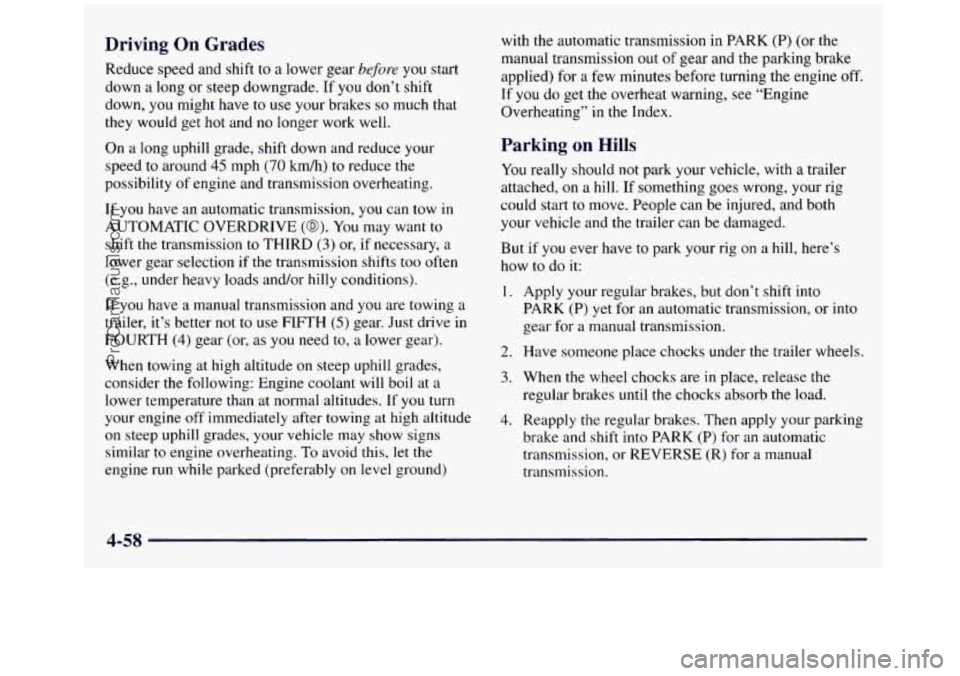
Driving On Grades
Reduce speed and shift to a lower gear before you start
down a long or steep downgrade. If
you don’t shift
down,
you might have to use your brakes so much that
they would
get hot and no longer work well.
On a long uphill grade, shift down and reduce your
speed
to around 45 mph (70 kdh) to reduce the
possibility
of engine and transmission overheating.
If you have an automatic transmission, you can tow in
AUTOMATIC OVERDRIVE
(@). You may want to
shift the transmission
to THIRD (3) or, if necessary, a
lower gear selection
if the transmission shifts too often
(e.g., under heavy loads and/or hilly conditions).
If
you have a manual transmission and you are towing a
trailer, it’s better not to
use FIFTH (5) gear. Just drive in
FOURTH
(4) gear (or, as you need to, a lower gear).
When towing at high altitude
on steep uphill grades,
consider the following: Engine coolant
will boil at a
lower temperature than at normal altitudes. If you turn
your engine off immediately after towing
at high altitude
on steep uphill grades, your vehicle may show signs
similar to engine overheating. To avoid this, let the
engine run while parked (preferably on level ground) with
the automatic transmission in
PARK (P) (or the
manual transmission out of gear and the parking brake
applied) for a few minutes before turning the engine
off.
If you do get the overheat warning, see “Engine
Overheating’’ in
the Index.
Parking on Hills
You really should not park your vehicle, with a trailer
attached, on a
hill. If something goes wrong, your rig
could start to move. People can be injured, and both
your vehicle and the trailer can be damaged.
But
if you ever have to park your rig on a hill, here’s
how to do it:
1.
2.
3.
4.
Apply your regular brakes, but don’t shift into
PARK
(P) yet for an automatic transmission, or into
gear for a manual transmission.
Have someone place chocks under the trailer wheels.
When the wheel chocks are
in place, release the
regular brakes until the chocks absorb the load.
Reapply the regular brakes. Then apply your parking brake and
shift into PARK (P) for an automatic
transmission, or REVERSE (R)
for a manual
transmission.
4-58
ProCarManuals.com
Page 247 of 452
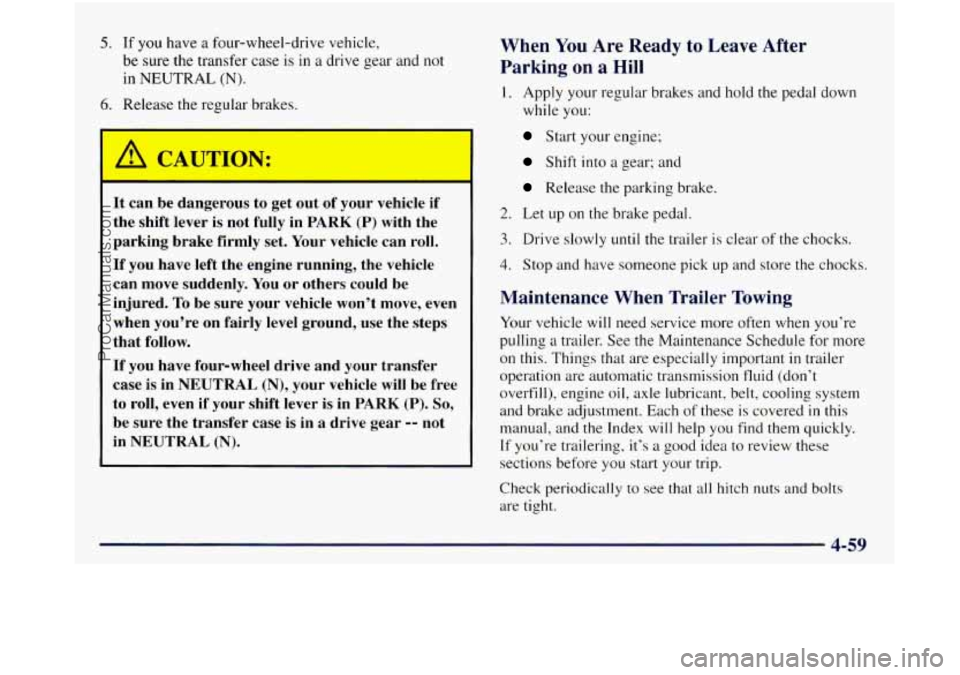
5. If you have a four-wheel-drive vehicle,
be sure the transfer case is in
a drive gear and not
in
NEUTRAL (N).
6. Release the regular brakes.
-
/r CAUTIOIA:
It can be dangerous to get out of your vehicle if
the shift lever is not fully in
PARK (P) with the
parking brake firmly set. Your vehicle can roll.
If you have left the engine running, the vehicle
can move suddenly. You or others could be
injured.
To be sure your vehicle won’t move, even
when you’re on fairly level ground, use the steps
that follow.
If you have four-wheel drive and your transfer
case is in
NEUTRAL (N), your vehicle will be free
to
roll, even if your shift lever is in PARK (P). So,
be sure the transfer case is in a drive gear -- not
in
NEUTRAL (N).
When You Are Ready to Leave After
Parking
on a Hill
1. Apply your regular brakes and hold the pedal down
while you:
Start your engine;
Shift into a gear; and
Release the parking brake.
2. Let up on the brake pedal.
3. Drive slowly
until the trailer is clear of the chocks.
4. Stop and have someone pick up and store the chocks.
Maintenance When Trailer Towing
Your vehicle will need service more often when you’re
pulling
a trailer. See the Maintenance Schedule for more
on this. Things that are especially important
in trailer
operation are automatic transmission fluid (don’t
overfill), engine
oil, axle lubricant, belt, cooling system
and brake adjustment. Each of these is covered in this
manual, and the Index will help you find them quickly.
If you’re trailering, it’s a good idea to review these
sections before
you start your trip.
Check periodically
to see that all hitch nuts and bolts
are tight.
ProCarManuals.com
Page 251 of 452
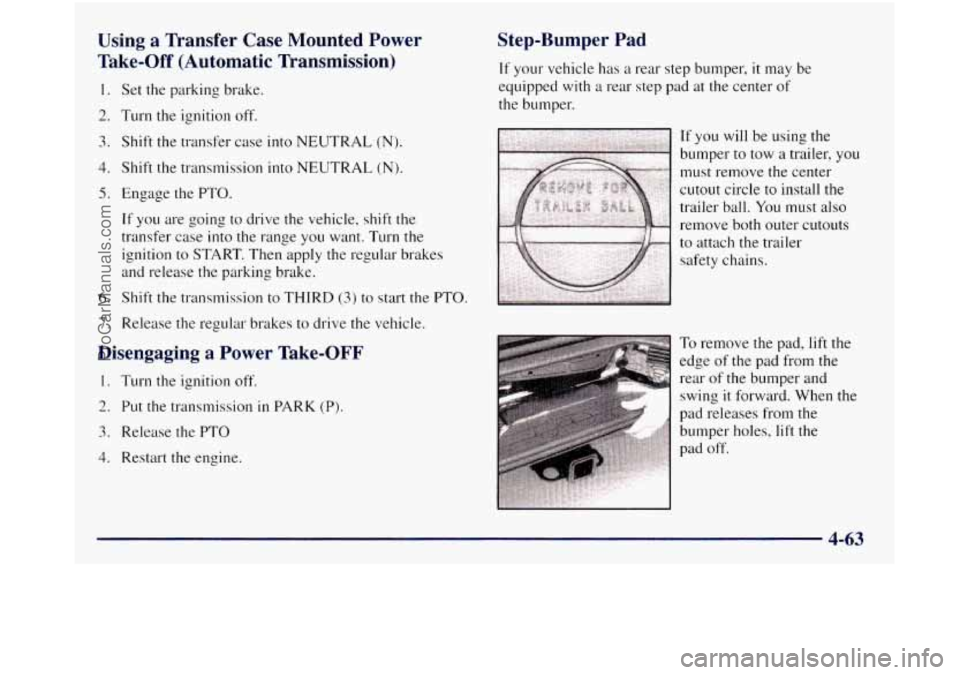
Using a Transfer Case Mounted Power
Take-Off (Automatic Transmission)
1.
2.
3.
4.
5.
6.
7.
Set the parking brake.
Turn the ignition off.
Shift the transfer case into NEUTRAL
(N).
Shift the transmission into NEUTRAL (N).
Engage the PTO.
If you are going to drive the vehicle. shift the
transfer case into the range you want. Turn
the
ignition to START. Then apply the regular brakes
and release the. parking brake.
Shift the transmission to THIRD
(3) to start the PTO.
Release the regular brakes to drive the vehicle.
Disengaging a Power Take-OFF
1. Turn the ignition off.
2. Put the transmission in PARK (P).
3. Release the PTO
4. Restart the engine.
Step-Bumper Pad
If your vehicle has a rear step bumper, it may be
equipped with
a rear step pad at the center of
the bumper.
If you will be using the
bumper to tow a trailer,
you
must remove the center
cutout circle to install the
trailer ball.
You must also
remove both outer cutouts
to attach the trailer safety chains.
To remove the pad,
lift the
edge of the pad from the
rear of the bumper and
swing it forward. When the
pad releases from the
bumper holes,
lift the
pad off.
4-63
ProCarManuals.com